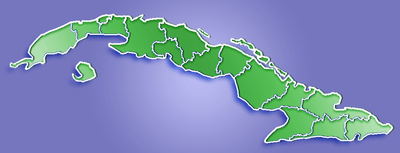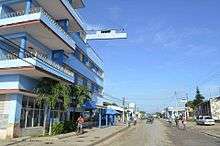Colón, Cuba
| Colón | |
|---|---|
| Municipality | |
|
School of Arts | |
.png) Colón municipality (red) within Matanzas Province (yellow) and Cuba | |
 Location of Colón in Cuba | |
| Coordinates: 22°43′21″N 80°54′24″W / 22.72250°N 80.90667°WCoordinates: 22°43′21″N 80°54′24″W / 22.72250°N 80.90667°W | |
| Country |
|
| Province | Matanzas |
| Founded | 1846[1] |
| Established | 1859 (Villa) |
| Area[2] | |
| • Total | 597 km2 (231 sq mi) |
| Elevation | 60 m (200 ft) |
| Population (2004)[3] | |
| • Total | 71,579 |
| • Density | 119.9/km2 (311/sq mi) |
| Demonym(s) | Colombino |
| Time zone | EST (UTC-5) |
| Area code(s) | +53-52 |
Colón is a municipality and city in the Matanzas Province of Cuba.
Geography
The municipality is divided into the campos of Agüica, Este, Guareiras, Jacán, Laguna Grande, Oeste and Palmillas.[1]
History
The town was founded in 1836, under the name Nueva Bermeja. In 1851 the railroad reaches the town. In 1859, it achieves the status of villa (town) with the name Colón. The founder's name is don Martín José Zozaya, who founded the town in the former hacienda named La Bermeja. The deed to establish this town was signed in the city of Matanzas in 1836. At the time, don Martín set apart land for a cemetery and a church. The original name of the town was La Nueva Bermeja. The railroad had arrived near the new town in 1843 but did not cross the town until 1851. In 1852, Fernando Diago, the owner of the sugar-mill Ponina, inaugurates the first public school in town. The city of Columbus is the head of her own municipality in the province of Matanzas, Cuba. The municipality limits the north and northeast with Martí, with Calimete south, south and southeast Jaguey Grande, west and northwest by Perico, and on the east by the Arabos. By Royal Order the greater office of a mayor was established on August 19, 1855. The first Municipal Board was established on September 10, 1858, together creating the Captaincy by Ceja de Pablo, Hanabana, Macurijes, Macagua, Jiquimas and Palmillas, joining more Later; the first one to Sagua and the remaining five to Columbus. The City Council was created on July 27, 1859 segregating of Palmillas.
It has an area of 597 square kilometers and a population of 71,563 inhabitants.
It is divided into neighborhoods Agüica East Guareiras, Jacan, Laguna Grande, West and Palmillas.
An important trade center, with modern buildings and parks, gardens and monuments. The city was founded on August 8, 1836 under the name New Bermeja, this being the farmyard where he settled near some mounds there on the north side and on level ground. In 1855 he became jurisdictional term and changed the name to Columbus, the only Cuban village to bear the name of Admiral Don Christopher Columbus. In 1846 there were 17 houses of wood and tiles and as many of guano, with a population of 189 people; according to the statistical table, which in 1861 had been laid out in 1,593 inhabitants. The railroad had arrived near the new town in 1843 but did not cross the town until 1851.
In 1852, Fernando Diago, the owner of the sugar-mill Ponina, inaugurates the first public school in town.
Architecture

The city of Colón since its founding on August 8, 1836, has gone through different architectural styles, some of them on specific buildings and others that were emblematic in different stages, but left a very strong imprint that identifies this beautiful villa and ranging from Neoclassicism, through the Balloon Frame, Eclectic, Art Nouveau, Art Deco, until rationalism. It can be seen in its streets, well marked and different styles of its buildings. The peak of the neoclassicism can be admired in the Catholic temple founded December 8, 1872, and the Town Hall. In the late 1880s, as atypical and off note of the layout of the town, was built the Quinta de Tirso Mesa, an irrefutable example of the introduction of Balloon Frame and the phenomenon of acculturation in our architecture. Now This building is gone, but it has left a mark on the population still remembered for its beauty. The introduction of eclectic at Columbian architecture was made with the construction of the School of Arts and Crafts, built between October 16, 1911, and November 28, 1912. While not renouncing some neoclassical codes, in this style can be mentioned other constructions such as Ferrolana, Provincial Agricultural College (now Polytechnic Institute of Health Mario Muñoz), etc. The period 1930-1959 meant a lot to the city for two main reasons: the opening in 1930 of the section of the Central Highway between Havana and Santa Clara, and the rise to mayor of Jose Manuel Gutierrez Plans (1927 - 1933), under whose mandate is several architectural gems appeared, such as the New Continental Hotel (1937), resulting in a new architectural style in the city, Art Deco, with the Canal Theatre as its finest example. Between 1948 and 1959, rationalism makes its entrance into the city, and the best examples can be seen in the Santiago-Havana and Grand Charity hotels.
Economy
Colón's economy is centered around agriculture (sugarcane, tobacco, citrus fruit, honey) and stock raising. It is also an important railway center.
Its strategic geographical and commercial situation is exceptional, no wonder being such progress. In 1851 a bus stop railway was built; in 1855 greater mayor for some time worked in Cardenas because of the lack of local until 1856 that also came the trial. Andriani Governor Cardenas put the greatest effort into development and thanks to the zeal that existed in 1857 and five straight streets of houses, having replaced the old chapel of a church spacious and beautiful stonework, under the invocation of San Jose. In 1857 the first industrial and agricultural exhibition, whose expenses covered the landowner Fernando Diago, who also paid for the building to prison and whose work began in 1858. On April 27, 1859 was created this council, separating from Palmillas held. In the same year he was awarded the title of Villa Colón.
In 1902 annexed some neighborhoods into the municipality. As the city has grown, it has dropped the term, not just for the aggrandizement and absorption of this header, but also by the growth of the surrounding neighborhoods, who have come to gather enough to establish themselves their own municipal population. The jurisdiction of Colón is one of the largest on the island. Colón became a city full of attractions and sitting at the foot of the Central Highway and center, while surrounded by an extensive network of railways
Demographics

In 2004, the municipality of Colón had a population of 71,579.[3] With a total area of 597 km2 (231 sq mi),[2] it has a population density of 119.9/km2 (311/sq mi).
 Locomotive 1851 in Colón, Cuba
Locomotive 1851 in Colón, Cuba Colonial Castle in Colón, Cuba
Colonial Castle in Colón, Cuba- Afro-Cuban Society -1950, La Nueva Aurora in Colón, Cuba
See also
- Colón (Cuba) Colón, Matanzas, Cuba (Spanish)]
- San José de los Ramos
- Municipalities of Cuba
- List of cities in Cuba
References
- 1 2 Guije.com. "Colón" (in Spanish). Retrieved 2007-10-07.
- 1 2 Statoids (July 2003). "Municipios of Cuba". Retrieved 2007-10-07.
- 1 2 Atenas.cu (2004). "2004 Population trends, by Province and Municipality" (in Spanish). Archived from the original on 2007-09-27. Retrieved 2007-10-07.
- Colón: en el 150 aniversario de su fundación, published in Cuba in 1986.
External links
| Wikimedia Commons has media related to Colón. |
 |
Cárdenas | Martí |  | |
| Perico | |
Los Arabos | ||
| ||||
| | ||||
| Jagüey Grande | Calimete | Rodas |
